Another Spanish sayings and proverbs, 53
Wednesday, November 27, 2013
Many times I have hear this expression, and I want to share it with you:
A trancas y barrancas = Through thick and thin
This is a phrase with mule driver lineage, which is often used as an expression of victory over the obstacles opposed to any effort. For example, we should say: "We sweat a great time, in fact, but in fits and starts, we reached the crater".
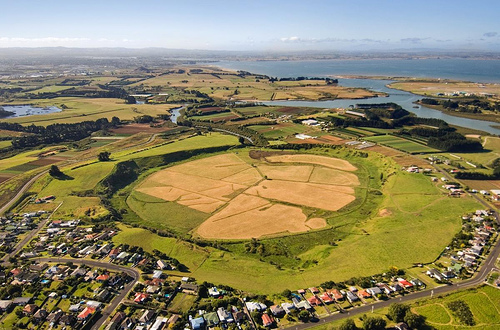
Pukaki Crater, Manukau, by Dave, at flickr.com
I hope that you have liked.
Till soon, kind regards,
Luis.
Sponsored by Costaluz Lawyers.
Please click down here:

 0
Like
Published at 11:55 AM Comments (0)
0
Like
Published at 11:55 AM Comments (0)
Knowing the origin of the Olive in Spain
Wednesday, November 27, 2013
Has been completed the first phase of reading of the DNA olive, an ancient tree. This reading could help improve olive production.
A project led by the Higher Council for Scientific Research (CSIC) has initiated a study, that is expected to last for three years, that seeks to find genetic clues that could help the olive tree to improve olive production. Currently, the research team has achieved a first complete DNA sequencing of this tree.
The study, funded by Santander Bank, is being carried out on the sequencers of the National Centre for Genomic Analysis and the computers of the Centre for Genomic Regulation.
The project is led by the researcher of the CSIC, Pablo Vargas, of the Royal Botanic Gardens, where it has been carried out the DNA extraction of the individual studied. It is an olive tree variety "Farga" (“Forge”), aged scientifically estimated between 1,100 and 1,300 years old, originating from the Sierra del Maestrazgo (Castellón, Esatern Spain), reported by the CSIC in a note.
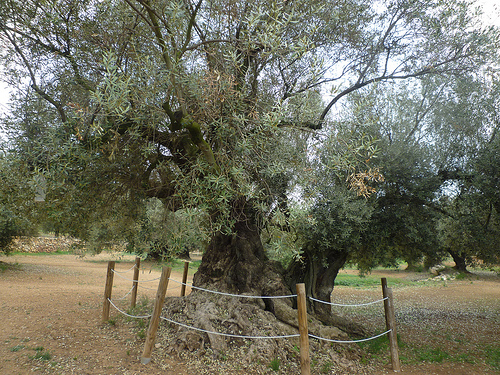
La Farga, olivera bi-mil-lenaria, by Matilde Martínez, at flickr.com
In 2005, it was transplanted into the gardens of the Banco Santander Financial City in Boadilla del Monte (Madrid), which is alive and growing. The olive tree, called Santander, weighs about 11 tons and has a perimeter of about five meters. The Forge variety has been chosen to be the type of olive tree with the most ancient individual in Spain.
"Reading DNA olive is a milestone in the field of genetic sequencing, because it is a kind of extraordinary longevity. All the organisms sequenced so far are living a few years, depending on the life expectancy of each species. However, this is the first time you do with a subject that has existed over a thousand years and probably get to live many more ", explains Vargas.
The data collected so far, corresponding to the raw sequencing, have been included this week in the European repository nucleotides (European Nucleotide Archive).
The results of this work will allow in-depth knowledge of a plant that is part of life and the power of human beings from about 8,000 years ago, when it began a process of domestication of wild olive, from which current olive emerged.
"DNA sequencing of the olive tree will reveal the genetic basis of that domestication process; it will give the keys of local adaptations that have enabled the species to survive and allow us to confirm its origins. All this information will help in future genetic improvement of olive production, of great importance in the Spanish economy”, Vargas concludes.
This study seems to be very interesting ; is not it?.
Till soon, kind regards,
Luis.
Sponsored by Costaluz Lawyers.
Please click down here:

 0
Like
Published at 12:47 AM Comments (0)
0
Like
Published at 12:47 AM Comments (0)
Your Opportunity in Spain
Tuesday, November 26, 2013
“Your Opportunity” is a new program, in the Spanish Television, that gives an opportunity to new Entrepreneurs, through the employers, experienced, Maria Eugenia Girón, Catherine Hoffmann, Javier Pérez Dolset, Gonzalo de la Cierva and Pablo Gimeno.
I have liked the case of Jose Luis García Martínez (Founder Fidiliti, a solution that allows to business and users manage loyalty cards and be able to carry on mobile phone in a simple and easy to use).
Jose Luis went to the program with the idea of offering 8% of the company, in exchange for 110,000 Euros. But he found that all investors, except one, were out of supply.
If you want to watch the result, please click down here, on the link:
http://www.rtve.es/alacarta/videos/tu-oportunidad/tu-oportunidad-fidiliti/2158490/
The Entrepreuner: “ Hi, I am Jose Luis Garcia Martinez , Founder of Fidility, and we are looking for 110,000 Euros for 8% of the company. Fidility is a solution , which allows, to businesses and users, manage loyalty cards and be able to lead them in the mobile phone , in a very convenient, simple and easy to use. The problem, that we detected is that the user does not want to register with loyalty programs .I am sure you did that happen , ever , and also that our portfolio is not infinite, we must decide what we want to bring cards on us. Our solution is a new means of communication and loyalty , which allows companies to have a presence on the mobile client , which is increasingly important ; allows presence in social networks , through their customers, they will use their brand, they will be they prescribers of their brand , they will allow to know the profile of the customer, because they will know exactly when their customer has selected their card, when it has read a promotion, when it has read an offer, when used .. . ".
The presenter of the program: “Jose Luis seeks an investment of 110,000 Euros, in exchange for yielding 8% of "Fidility". Javier will be the first to ask”
Javier Pérez Dolset: “Do you have material after a year?”
Jose Luis: “Currently we have over 30,000 users, who are using the application, but we really what we focus is on getting agreements with companies. It is an important thing that, currently, companies are spending among 3 to 5 Euros, per user per year. ..: the whole issue of attracting users, the loyalty card, the display of that card with customer data, and with our system companies can save substantially ....”
Gonzalo de la Cierva: “And how many companies have you already within the application now?"
Jose Luis: “There are currently 18 companies within the application”
Javier: “How much everyone pay you per user?”
……......a little silence……………………..
Jose Luis: “But the companies are paying among 0,20 and 1 Euro, per user each year…..; then, companies like for example…..”
Javier: “And with that, they have full access to services of the platform…., I mean that is very economical for them”
Jose Luis: “Fully, indeed”
Javier: “How you invested to date?”
Jose Luis: “But, to date, we have invested about 150.000 Euros”
Maria Eugenia Girón: “How much have you deposited?”
Jose Luis: “In the last year, we have deposited about 40.000 Euros”
Javier: “What is the billing that have seen a very planned, sorry Paul, for this year?”
Jose Luis: “For this year, 80.000 Euros”
………a little silence……………………
Catalina Hoffmann: “I am really not the right person to be in your company, of course the product is good………..I am out, but congratulations”
Jose Luis: “Thanks”
Pablo Gimeno: “Jose Luis, I think that the keys you have are not only to be the first one in this, but having an alive and fast sales team that makes entering the large (companies) faster than your competition…… However, that same is what scares me a bit: the barriers to entry to competitors, with big monsters, which are walking on the network, which can hurt you; so, in this case, I will be out”
………..a little silence……………..
Maria Eugenia: “It is not for me a sector that ... I understand these comparative advantages, although you have described them great ..... ; for that reason I am out”
Jose Luis: Thank you very much”
----------------a big silence……………………
Jose Luis: “What are you thinking…?”
…………..a silence with stress………………..
Jose Luis: “You remain two…..”
………a silence with stress…………………
Gonzalo: “I should tell you that remain, if you have seen the profiles, the two almost specialists in technology and mobile, who are the ones we are thinking more”……..
…an stress……………………..
Gonzalo: “And I think that everyone is waiting for the other to speak first……………………….As Javier is on absolute silence, I speak….It is an idea I like, I love it and would make you an offer, if it was not because I think the 30,000 valuation today is excessive .... I am out, in an absolute novelty, provisionally…………………….Ie ... to see if my partner goes and how assessment”
Javier: “The problem that ....... you have chosen an industry that has a problem to be solved, but it is one of the biggest, most powerful sectors and there are more people and you will find companies that have millions user ...... I would tell you the following: I give you ... I mean you get the critical mass, I give internationalization and funding that you go ..... need to develop this .....; in exchange for all that, I would have: 1: 30% of the company; 2: of course I have a clause where you may not cheat or sell it to any of my competitors, and 3: the pace of development and countries where this is going to be the move that I check”
……………Silence……………………
Jose Luis: “We would have to see all those conditions, who are your competitors, what countries are you going to want to throw it”
Javier: “Competitors…......, today, small, few ......, we are the biggest company in the world we doing that by far ....... So .... I have not told you the figure ...... and I have not said it on purpose, because .... what I want is that you tell me what it is, what it is what you would consider fair, exchange for all that I am giving you”
……….little silence……………………..
Jose Luis: “We really, in a next stage, in a next round of funding, we would be looking for 500,000 Euros, for a next step, then, would be somewhere between 100 to 500 now and then, and ..... . bequeath to an intermediate amount by 30% ….”
…………….a little silence…………………..
Javier: “I give you 250.000 for the 30”
Jose Luis: “I think that you can add a little more”
Javier: “Yes, but I do not want. I want you to sweat it”
………a little silence…………..
Jose Luis: “There is another……you still were awaiting, perhaps you improve it….”
Gonzalo: “I, in the wake of the offer made by Javier, if I entered in the company, I should consider myself a simple opportunist or a parasite of what you are going to develop among you; thus, now yes I am out definitely”
…….a little silence……………………..
Jose Luis: “Ehhhhh, but let me for a second, that I am going to consult it”
…………….waiting for a moment……………..
The presenter of the program: “Jose Luis is out of the trick of Gonzalo, in order to trade before Javier and he will have to decide whether or not to accept his offer”
……..a little silence……………
Jose Luis: “Here what we see is that the valuation is a bit low at the end ... you have dropped it to us.... significantly. We value all you can provide, but we have another investor who invested a small amount, a few months ago, and with a valuation of a million ....; then, well ... if you can climb instead of 250,000 to 300,000, we could keep that valuation, for that other investor and we could enter more easily ... sure that you do not pose any any problem ... I think that we can help, each other ..... and we can go forward ........ trying to adjust that amount”.
…a little silence…………
Javier: “Well, I agree........................ Congratulations "
Jose Luis: “Thank you very much”
The presenter: “Jose Luis….Congratulations…….You get loyalty Javier Perez .......... How about, happy?”
Jose Luis: “Much, much…”
The presenter: “What a negotiation such combative, such hard…”
Jose Luis: “Well….It has not been much….”
The presenter. “He has been hard to get ...”
Jose Luis: “A little, but hey, it was interesting…”
The presenter: “Are you happy?”
Jose Luis: “Much”
The presenter: “Good luck”
Jose Luis: “Thank you very much”
The presenter: “Hold on!”
Jose Luis: “Thanks”
Maria Eugenia: “We will register us into all these cards”
I hope that you have liked this article; if you did not like it, please you may tell me why, thanks.
Till soon, kind regards,
Luis.
Sponsored by Costaluz Lawyers.
Please click down here:

 0
Like
Published at 12:45 AM Comments (1)
0
Like
Published at 12:45 AM Comments (1)
The Medulas of Leon, Spain
Friday, November 22, 2013
The Medulas of León is an area situated in the Northwestern Spain (to the South on Galice), in the named region of Castille-León.
It was one of the major gold deposits of the Roman Empire and I want to tell you about it through the program of tv “Spain flush with sky”:
http://www.rtve.es/alacarta/videos/espana-a-ras-de-cielo/espana-ras-cielo-medulas-leon/2068727/
The video starts with Francis Lorenzo (the presenter) talking about the Médulas: “Nature has been extremely generous , with Spain , in terms of natural resources : red, black , green , blue and white are colors under which that wealth is hidden ..... We are going to see how we transform our valleys , deserts , mountains and rivers to harness natural resources of our geography ......... Today in Spain flush with sky , we took the colors of our country ............... ...................... We starte our trip , flying over the region of El Bierzo .... 2000 years ago , Spain suffered a real “gold rush" .. .... The Romans discovered the largest gold deposit of the Empire, in the population of The Medulla, and exploited it over 300 years ..... Undid the mountains with water and the result of this work is so huge red stunning landscape , which seems to come from another planet and has been declared “world Heritage " ....... I will find out how the Romans were able to perform these original excavations ; I expected an exciting day , by the biggest expert about Roman Mining Engineering of the country, Roberto Matias ...... Hi , what is up? ... Roberto ? ".
Roberto Matías: “Hi, What is up?"
Francis: “What a gladness….!, I was so eager to meet you….!.....It is my horse…?”
Roberto: “Yes, this is your horse”
Francis: “Let us go to him….!.....Where are you taking me?”
Roberto: “We are going to see this wonder, which is the largest mine, that was done in the ancient world”
Francis: “At no place in the world….?”
Roberto: “At no place”
Francis: “But I want to see it”
………………………………………………………………..
Now, you can read on the image: The mines were active for 250 years.
Francis: “By here….?”
Roberto: “By up there”
Francis: “Roberto, What is this ….?!”
Roberto: “Hundreds of millions of cubic meters, moved by the hand of man ...., cutting the mountain with water jets, literally”
Now, you can read on the image: The Medulas Gold is valued at 51.187 million euros .......
Francis: “How came they get here?”
Robert: “It is speaked of many figures, but still to be determined. Pliny told us some data: 20,000 pounds of gold, which is 6 tons per year, but throughout the whole area”
Now, you can read on the image: ……...equivalent to the fortune of Bill Gates, the richest man in the world.
Francis: “What will be something for me?”
Robert: “No, the Romans took everything”
Francis: “It is amazing how the hand outside of Man has been able to crumble a whole mountain ......... We are approaching an area where you can see inside ........ What a red , right?!”
Robert: “Red, clay like pots of a lifetime ..... Imagine the water, running around here ..., removing the mud and undermining the mountain ..... "
Now, you can read on the image: The Medulas were exploited since the time of Emperor Octavian Augustus until the third century.
Francis: “It was opening the mountain….”
Robert: “It opens it, the mountain barefoot it self, and when it lose the consistency, buuuuuuuu, also hit”.
……………………………………………………………….
Francis: “We do a reconstruction of the mountain as it was before the Romans rid it”
Robert: “With a sound stunning, a gigantic avalanche, but in this case of stone”
Francis: “And when the flood felt down, What it did, descended all over here to the river, such as sludge, as rivers of mud?”.
Robert: “Exactly, the earth fell, as it was wet and there slope, it was going down by itself ... like the current floods, but controlled, controlled; in fact, the Romans applied what they saw in Nature, in order to develop the field it was .... one of the mines, for their size, most important of the Roman Empire ... One, no ...., the most important of all".
Francis: “How many people worked in a mine like this?”
Robert: “The myth of the thousands of slaves working here, with pick and shovel…let us forget it .... ".
Francis: “What was the reality, was water which made everything?.
Robert: “Water, simply”
Now, you can read on the image: These mines had as many kilometers of piped water as Roma
Francis: “How did such a water get into a place like this?
Robert: “Rivers surrounding the area, carrying channels to them, a total of 600 km of canals”
Francis: “How good this, how good .........!”
…………………………………………………..
Francis: “After Roberto's words, I have interest of knowing, from within, the channels through which water circulated undoing these mountains”
……………………………………………………
Robert: “It costs go up ... Huh?”
Francis: “This soil would be that”
Robert: “That is the same, that came down, because underneath, the Romans took the field with water”
Francis: “And why the Romans chose this site ...? How do they know that there is gold here?”
Robert: “Because this field, when it felt the water, dragging mud particles to the rivers, and along the rivers, could get here ... hitting the rivers, as it is currently done ... "
Now, you can read on the image: An average yield of 3 grams of gold per tonne of land was mined
Francis: “So, let us enjoy this little while, just a moment, you and I”
……………………………………………………………………..
Francis: “But….”
To be continued….
Till soon, kind regards,
Luis.
Sponsored by Costaluz Lawyers.
Please click down here:

 0
Like
Published at 11:48 PM Comments (0)
0
Like
Published at 11:48 PM Comments (0)
Discovered in Spain an enzyme that repairs DNA
Wednesday, November 20, 2013
The PrimPol protein recognizes DNA damage and repair it.
PrimPol is an evolutionarily ancient enzyme.
Scientists are already studying their role in disease development.
The human body produces every day new cells to regenerate tissue and repair those, which have suffered injury. Each time this happens, the cells make copies of their DNA, to be forwarded to the resulting daughter cells.
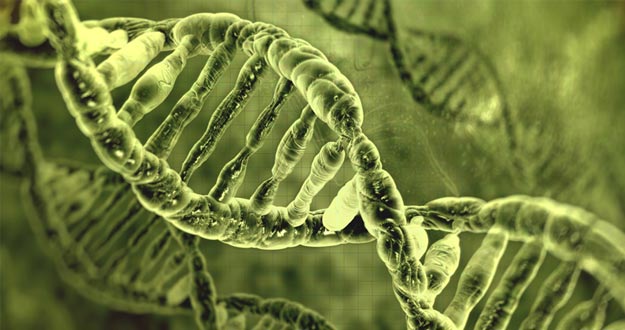
DNA molecules
This process of copying DNA, also called replication, is very delicate, and it can cause serious DNA alterations associated with tumor transformation or aging.
Researchers at the National Cancer Research Centre (CNIO) led by Juan Mendez, head of the DNA Replication Group, in collaboration with Luis Blanco, of the Centre for Molecular Biology Severo Ochoa (CBM-CSIC), have discovered how a human enzyme, the PrimPol protein is able to recognize DNA damage and facilitate repair during the copy process, preventing irreversible and fatal damage to the cells and the organism.
The results are collected by the edition of the journal Nature Structural and Molecular Biology, which are a continuation of previous work recently published by the same researchers in the journal Molecular Cell, in which were described the existence and the biochemical properties of the enzyme PrimPol .
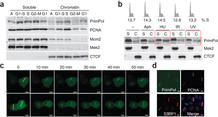
The PrimPol enzyme, associated with nuclear chromatin in S phase and in response to DNA damage
The DNA, that resides in the nucleus of cells, is the carrier of genes, the instruction manuals that dictate cell function. "The structure of the DNA is very stable, except for about eight hours, that replication takes in human cells. Then it becomes more fragile and can break”, says Mendez.
These eight hours are therefore critical to the cells: they have to monitor that the copy is accurate, and if there are errors or DNA damage, they have to repair them in the most efficient manner possible.
The enzymes, that synthesize new DNA copies, are the DNA polymerases. "When a DNA polymerase encounters an obstacle in DNA [for example, a chemical alteration introduced by ultraviolet radiation from sunlight], the copy is interrupted and stop until the error is being repaired. This disruption can cause DNA breaks, translocations of chromosome fragments of some others and even cause cell death or tumor transformation”, says Mendez.
The research made by the CNIO and CSIC shows that the enzyme, PrimPol, prevents the copying process is interrupted when no harm: recognizing injuries and jumps, so that will be repaired when backup finishes.
The PrimPol is an evolutionarily ancient enzyme, and similar proteins were found in Archeobacteria, one of the first forms of life that inhabited the planet.
“Millions of years ago, the living conditions were harder [high salinity, extreme temperatures, etc..], So PrimPol probably adapted to synthesize DNA in these conditions favorable damage", said Mendez, adding that "in exchange these primitive DNA polymerases are less accurate than more advanced backup systems and can introduce mutations".
Scientists advance that this increase in mutations could have played a crucial role in the evolution of genomes, as well as having an impact on the aging of cells and cancer development. Identified and characterized this novel protein in humans, investigatorsadvanced that they are already studying its role in disease development.
I hope that Science further research, to increase the quality of life for many people.
Till soon, kind regards,
Luis.
Sponsored by Costaluz Lawyers.
Please click down here:

 0
Like
Published at 11:50 PM Comments (0)
0
Like
Published at 11:50 PM Comments (0)
The Alboronía: a delicacy from Andalusia and Castille La Mancha
Tuesday, November 19, 2013
The word “Alboronía” comes from the Arabic word al-baraniyya which means “some delicacy”, and effectively it is a real delicacy this stew of eggplant, tomatoes, peppers and squash, all well mixed with paprika and served in the days of Lent (in which is forbidden to eat meat). It is for its content and preparation the precursor of the Manchego ratatouille (from La Mancha, in the center of Spain) and other Spanish ratatouilles.
The Alboronía is also very popular in Andalusia.
Alboronía comes from “Al-baraniyya”, but also comes from “Buraniyya”, that in Arabic means “Guiso”(“Stew”).
With the discovery of America, Spain reach new products such as tomato and pepper, and paprika from here, which became the usual ingredients of the Alboronía.
The Alboronía was a very popular dish at weddings.
This dish spend 45 minutes to be cooked –but it is easy--.
Here you have the ingredients (for 4 persons): 1/2 kg of pumpkin. 2 aubergines. 1 onion. 1 zucchini. 2 cloves of garlic. 1 tomato. Olive oil. Sweet paprika. Sliced almonds. Black pepper. Salt.
In a pot , put water with salt to boil ; while boiling , we peel the pumpkin and the aubergines. When this is boiled, put the vegetables and leave ten minutes over medium heat; after which , we drain the vegetables and cut into small dice . Reserved .
Meanwhile, in large skillet , put a jet of olive oil, while heated over medium heat, peel , chop the onion, so fine, and cast to skillet. The peel garlic , cut them fine and add them to the skillet. When the garlic and onion are cooked , without ever taking color, wash and chop into small dice zucchini. After about five minutes, add a pinch of paprika , move and put into the pot the tomato , peeled, seeded and diced small . When everything is cooked, add the diced pumpkin and auberinge cooked , put a pinch of salt and pepper and the dish is done.
On four plates, place the alboronía , stretched and sprinkle sliced almonds.
And this one should be the result:
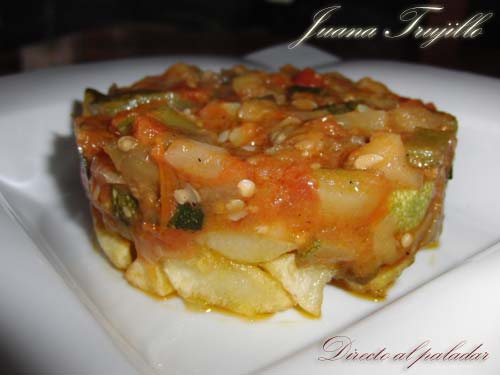
Alboronía.
I hope that you want to try it.
Enjoy it!.
Till soon, kind regards,
Luis.
Sponsored by Costaluz Lawyers.
Please click down here:

 0
Like
Published at 3:15 PM Comments (0)
0
Like
Published at 3:15 PM Comments (0)
Quince: a very Spanish product
Monday, November 18, 2013
Autumn is a time of quince and formerly it was made slow cooked.
The quince is rich in fiber and potassium, so it is very healthy.
Spain, with 15 million kilos, is one of the leading European producers.
Extremadura, Andalusia and La Mancha are large producing Communities.
Note: Now, please click on "El sol del membrillo"
Indeed, with the Autumn arrive quinces. I do not mean to a Victor Erice's film, "El sol del membrillo" (“The sun of the quince”), about the pictorial art of Antonio Lopez (one of the best realist painters, that we have in Spain). No, I am neither referring to the smaller town of Toledo, called "Quince", located a few kilometers from Talavera de la Reina. No, I mean a product more modest, but essential in our Mediterranean cuisine: the quince.
The quince is the fruit of the quince tree, a tree in the rose family, that grows in cold and temperate climates. Its fruit is pear-shaped yellowish-green color, with a thick skin and covered by a grayish hairiness, which is lost when it matures in autumn.
The flesh is hard and sour, even when the fruit is ripe, but very aromatic. Its flowers are white or pink and appear in spring. They are white or pink, with five petals.
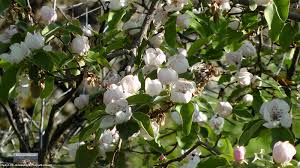
White flowers of a quince tree
In Spain there are a thousand acres under cultivation, all irrigated. The number of trees scattered exceed 62,000. We are large producers, with 15 million kilos, according to the latest data from the Ministry of Agriculture for the year 2009.
Extremadura, Andalucia, Castilla La Mancha, Catalonia and Murcia are the major producing regions. The absence of EU support and, above all, the high cost of sugar are affecting the decline of this farming, that we should recover in our diet.
The quince paste contains a high sugar content and therefore high caloric. Every 100 grams of quince paste contain 230 kilocalories. For sure, no cholesterol.
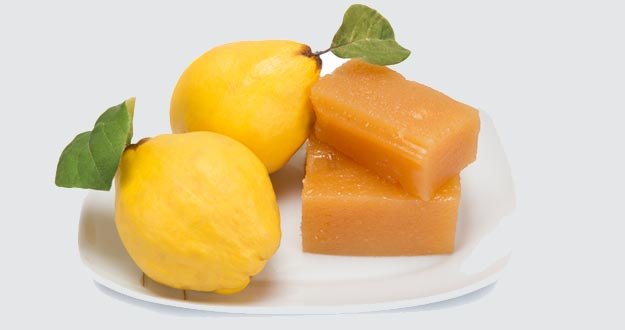
Two quinces and a piece of quince paste
Nutritional content of vitamins and minerals include, just except discrete quantities of potassium and vitamin C. Potassium is a mineral necessary for the generation and transmission of nerve impulses and normal muscle activity. Further it takes part in the balance of water inside and outside the cell.
Quince healthy properties are due to its abundance of fiber (pectin and mucilage) and tannins, substances that give it its astringent property par excellence.
It is also rich in malic acid, which provides the characteristic flavor of quince. This acid has disinfectant properties and promotes the elimination of uric acid. Finally, it brings polyphenols with antioxidant properties that prevent cellular aging.
The quince tree was cultivated since ancient Babylon, about 4,000 years before Christ. There are those who argue that the 'mysterious fruit of Eden' was not an apple, but a golden quince. As allegory of sin, it is not bad. Appetizing and appealing, it leaves a bitter taste if you eat it raw.
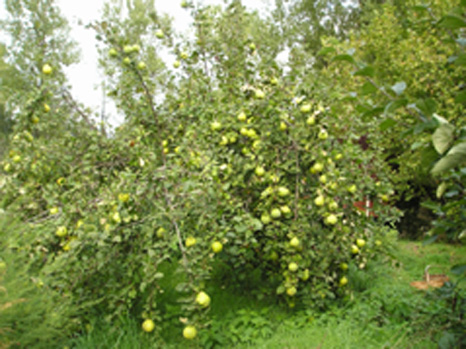
Un membrillero (a quince tree)
In ancient Greece, in the Cydonia region, on the island of Crete, the quinces or apples of Cydonia, were offered to Aphrodite, goddess of love, as a symbol of passion and fertility. This fruit also had a special meaning for the recently married, who had biting one before entering the bridal chamber.
According to Plutarch, Greek brides bited a quince sweeter than the present to perfume her mouth; so, that first kiss would not be unpleasant.
The Romans continued this tradition and left us recipes roasted quince with honey, sugar substitute, that they did not know. In the Middle Ages was a delicious ambrosia for kings and nobles. The Arabs used it as medicine greatly appreciated.
The Spanish people introduced the quince in America, from where sugar came to us, essential to make the quince paste. Uruguay and Chile stand out for their quinces sweeter.
“What is now known as 'quince paste' is very close to my childhood memories in Adrada, a town of Avila. It was the early 60s. At that time we children did not have 'playstation' , either could dream of a computer or 3D virtual sets. Everything was much simpler. I especially remember the smells and tastes of those years. Especially cabinets intense perfumed by the scent of quince.
The kitchen was magical, closed shop, where only women could access. A surprise for me was how to pout and pileup meantime tasty sweet could be achieved as the quince. We called it so. And unlike now, 'quince paste' or 'quince meat' ”.
"It is a matter of arms and patience," said my grandmother, as she prepared to fire the sweet delicious, passing from yellow to darker color by a process that seemed almost miraculous to me, a mystery most of my childhood, that I was discovering, little by little, as I was getting older”.
Quince is used practically everything. And until you can make a drink, that was the delight of our ancestors.
This is a recipe from "Sweet quince" (or “Quince paste”):
A kilo of quinces, previously boiled and cut so as to manipulate them better.
Sugar, 750 grams.
Two Pippin apple.
A carrot.
Preparation:
We grind all until a mush. Then we begin the most delicate phase. The cooking, and simmer, stirring a time, being careful with splatters. So we will avoid nasty burns.
As my grandmother said, it is "a matter of arms and patience." And after about half an hour, the quince is almost ready. We know it if we leave a spoon in the center and it is not moving. Let cool, always covered. Then molds and cold and retain the quince in the refrigerator. Watch and check. You will not regret. It is a pleasure for gods.
I hope that you test it.
Till soon, kind regards,
Luis.
Sponsored by Costaluz Lawyers.
Please click down here:

 0
Like
Published at 8:46 PM Comments (1)
0
Like
Published at 8:46 PM Comments (1)
Investigated in Spain to 4 proteins involved in breast cancer
Saturday, November 16, 2013
Several Spanish scientists identify four target proteins, involved in breast cancer. You have to know that there are four genes that produce the target protein in breast cancer processes.
These researchers have used genetic material chains to eradicate malignant tumors. Now, they will be able to study new therapeutic pathways on identified proteins.
A team from the Hospital Vall d'Hebron has identified a microRNA, leading to the discovery of new genes and metabolic pathways involved in the development of tumors related to breast cancer, miR-125b. The results have been published in the open access repository PLOS ONE and it opens the door to study new therapeutic avenues.(Click on PLOS ONE).
The finding, made by the group of Oncology and Molecular Pathology of the Research Institute in the University Hospital Vall d'Hebron (VHIR) allowed four target proteins detected in mammary tumors.
The team, whose study was funded by the BBVA Foundation and is led by researcher Matilde Lleonart, specifically has discovered the role of a microRNA or string of genetic material in the production process related tumors breast cancer, according SYNC gathers.
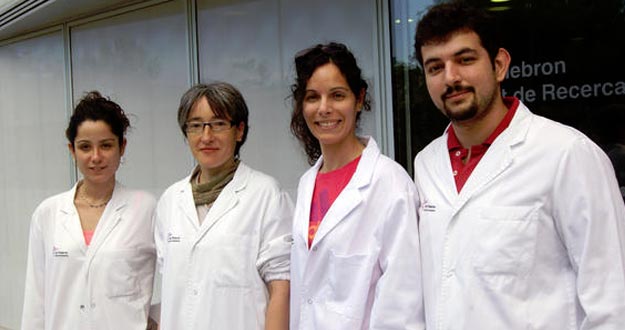
Andrea Feliciano, Matilde Lleonart, Mileidys Pérez and Antonio de las Heras, researchers of the Hospital Vall d´Hebron, Cataluña, North western Spain
MicroRNAs are capable of regulating the expression of hundreds of genes. Specifically, as of today it is known that more than half of all genes in our genome are regulated by microRNAs, so that their study is more than required and all hypotheses point to its key role in the process of tumorigenesis.
The research focuses preferably in the biological and functional characterization of microRNAs, whose expression is very different when comparing normal and tumor tissue from the same patients.
Only with the expression pattern of these small molecules microRNAs researchers can predict blindly without knowing the tissue of origin in the case of tumor tissue. MicroRNAs utility not only limited to the prognosis but also the diagnosis and therapy.
The work carried out at the Vall d'Hebron has the ultimate goal to characterize therapeutic microRNAs to eradicate malignancies. The group has come to identify up to 35 different microRNAs in breast cancer. It is chains of genetic material, as explained Lleonart "represent a molecular signature and therefore its expression, by itself, is representative of malignancy, since there are multiple genes acting on".
This line of research started some experimental works from human tumors, being the miR-125b the more differentiated,when compared the tumor tissue with normal, in breast tissue. Subsequently comparing the effect of miR-125b in different cell lines of breast cancer with varying degrees of tumorigenicity.
Thus, they detected four genes, -CK2-α, ENPEP, CCNK and MEGF9-, on which miR-125b is capable of acting and produce target proteins in breast cancer processes. Are genes ranging from previously unknown membrane receptor protein kinases universal. What miR-125b makes is to inhibit protein resulting from the expression of these genes.
To date, there are over a hundred therapeutic targets that are being investigated in preclinical and clinical trials, but only demonstrated the effectiveness of two targets in breast cancer: drugs that inhibit HER2 receptor overexpression and hormone receptors.
With the results of this study, Lleonart concludes that "the four newly identified target proteins in vitro cell lines were found to have an important role in mammary tumors in vivo, which opens the door to the study of new therapeutic avenues for the identified proteins , most of them unknown until now”.
One of the proteins will help determine the aggressiveness of tumors. Specifically, one of these proteins, the CK2-α, has been identified as a prognostic factor in breast cancer, the expression of which can assist clinicians in determining the aggressiveness of mammary tumors.
So good and very interesting!, is not it?.
Till soon, kind regards,
Luis.
Sponsored by Costaluz Lawyers.
Please click down here:

 0
Like
Published at 3:04 PM Comments (0)
0
Like
Published at 3:04 PM Comments (0)
A Spanish exoskeleton for children with disabilities
Friday, November 15, 2013
I can show you a video, where it is explained the work of a device for children with mobility problems:
http://www.rtve.es/alacarta/videos/telediario/investigadores-espanoles-desarrollan-exoesqueleto-para-ninos-problemas-movilidad/2143591/
Carlos Ruscalleda (the presenter of this video) says: “This skeleton is developed here: in one of the Robotics labs of the CSIC (Centro Superior de Investigaciones Cientificas) and it is a clear example of how scientific research is useful to society .... It is designed for children with degenerative problems. The rotors provide exact strength to complete the movement”.
Xavier Carrillo (Mechanical Engineer): “What you need is a mechanical part that deter you from going beyond what the human leg can actually go, because if not, we can hurt the person using the device”.
Carlos Ruscalleda: “In April, they tested with Daniela (quadriplegic girl of 9 years). Now, work in removing the structure by way of rods, supports her”.
Elena García (Automatic and Robotics Center of the CSIC): “We also increased mobility in the lateral plane and allow the movement of stabilization, faced with any disturbance or, simply, cause of the effect of walking”.
Carlos Ruscalleda: “They have created their own company, in order to manufacture it. They say that the Spanish Research is internationally, but not the Industry”.
Elena García: “And therefore we have had to create the company, at that level, because we have not found it in the national fabric”.
Carlos Ruscalleda: “Their next project: an autonomous robot for emergencies, able to perform search and rescue work”.
Honestly, I found this project very interesting, because it can help many children, who will soon be adults. I hope that you agree with me.
Till soon, kind regards,
Luis.
Sponsored by Costaluz Lawyers.
Please click down here:

 0
Like
Published at 11:54 AM Comments (0)
0
Like
Published at 11:54 AM Comments (0)
A Spanish robot that records images under the sea
Friday, November 15, 2013
Today, I want to talk you about a project that employs robotic mini-subs to record images.
The information collected is published on a Google Earth map to query data and photos.
Underwater robots can descend to a thousand feet deep.
In the seas and oceans of the world you can find all sorts of wonders and it is increasingly common among them some human talents are known as autonomous underwater vehicles that would be something like the drones flying but at the level of the deep sea.
Between the many companies that are engaged in this field worldwide, Feines d'Aigua Sub 2B, S.L. is one that is closest to us. Born in 2006 –although its creators began his own career in 1989, as major underwater world enthusiasts and fans of the image-- makes all kinds of activities and work underwater image recording, lately with renovated technology to suit the times.
Based on the Balearic Islands, it is supported by Hisparob (the Spanish Technology Platform for Robotics). In this platform, which depends on the Ministry of Economy and Competitiveness, meet many companies through whose initiatives and working groups develop research projects, creating products and integration of all types of systems.
The evolution of Feines d'Aigua Sub 2B and its little gadgets divers began like many amateurs and professionals who have years dedicating their cameras, robots and autonomous vehicles to assist in recording work documentaries and films, scientific research and other uses professional and business.
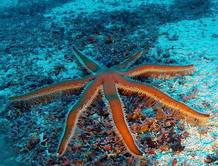
Starfish with 7-arms to 59 meters
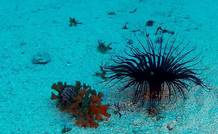
Cariantido to 49 meters
Between their equipment they have a small submarine, MiniRov, capable of descending to 150 feet underwater, to record with special video cameras everything that happens in the depths and a others larger one, just called ROV, that with the help of a long cable can descend to 1000 meters below the surface.
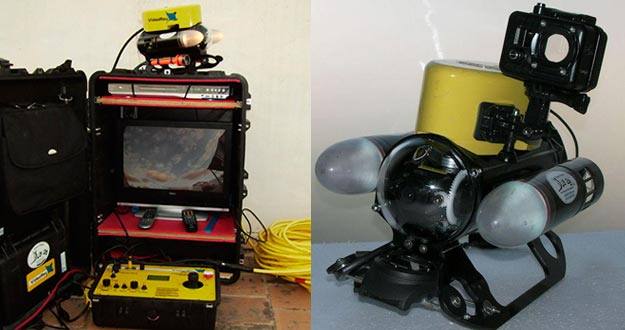
The MiniRov is a small robot equipped with motors, steering controls, sensors and a camera that records images underwater
Some of the jobs that they do, cover the entire process at both technical and personnel –it is a specialized task that is not easy--; but they also rent the equipment to see if any company or individual preferred to use them on their own.
In addition to the tasks they carry out little robots, are included hours and hours of divers, cameramen and technicians for tasks such as environmental studies, review of wells and pools or sample collection.
Between the projects that are planned for the near future, is included a recordings campaign seabed of the National Park of Cabrera Archipelago (south of Mallorca).
Another interesting aspect is that the information in all of these little robots dives is transferring to a logbook open public and can be found online: to see it, just visit the page with the web browser and the popular plug-in Google Earth.
All data are shown as points on the map from which just a click of the mouse to access images, fact sheets and video clips recorded during dives: a simple way to learn more about what gives our natural environment thanks to outlets often 'impossible' collected by these intrepid robots.
If you like diving maybe one day you can go to Mallorca to try one of these robots. But, anyway, I hope that you have enjoyed with this information.
Till soon, kind regards,
Luis.
Sponsored by Costaluz Lawyers.
Please click down here:

 0
Like
Published at 12:24 AM Comments (0)
0
Like
Published at 12:24 AM Comments (0)
Search mushroom in Spain with your mobile
Wednesday, November 13, 2013
The Scientific Research Council (CSIC) has created a mobile application called "Funginote" which helps identify mushrooms in the field.
This application is available on iOS - but later also be on Android - and the download is free this November. The app brings together 150 species, with photographs and features.
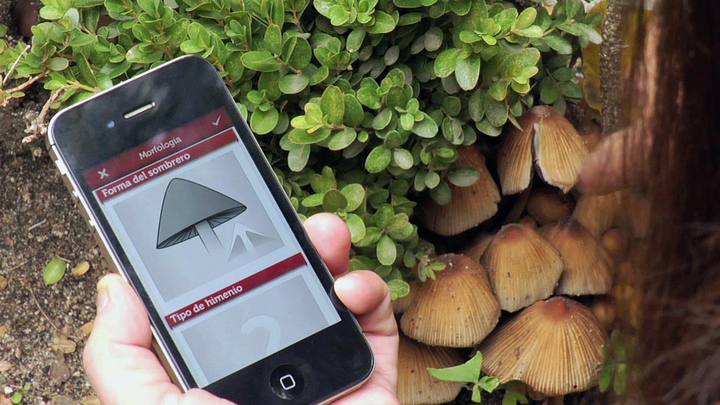
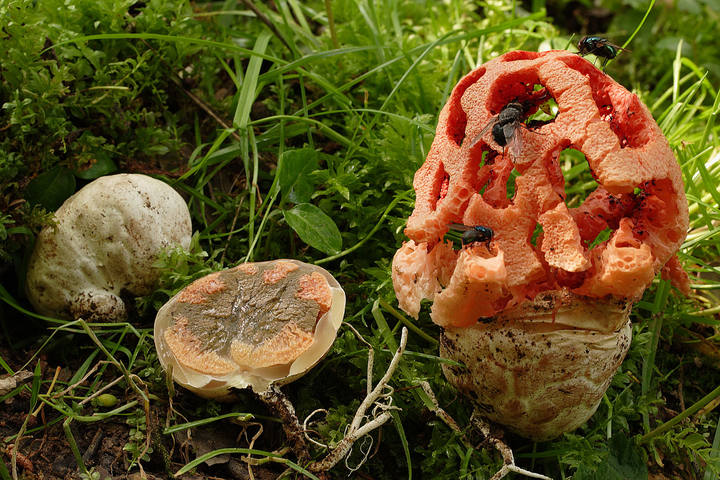
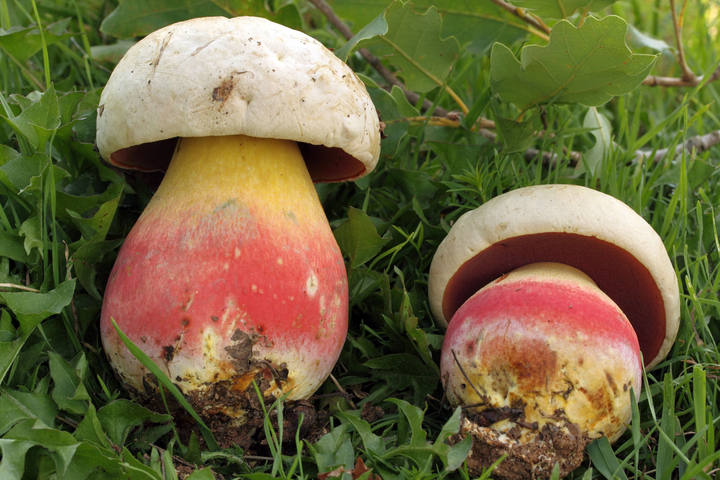
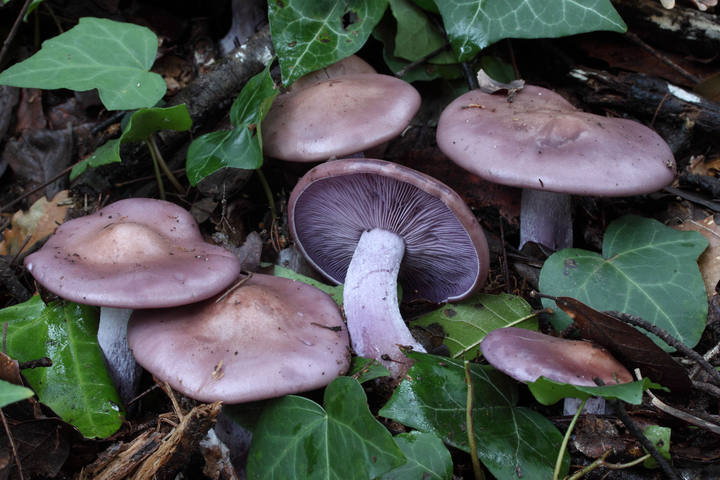
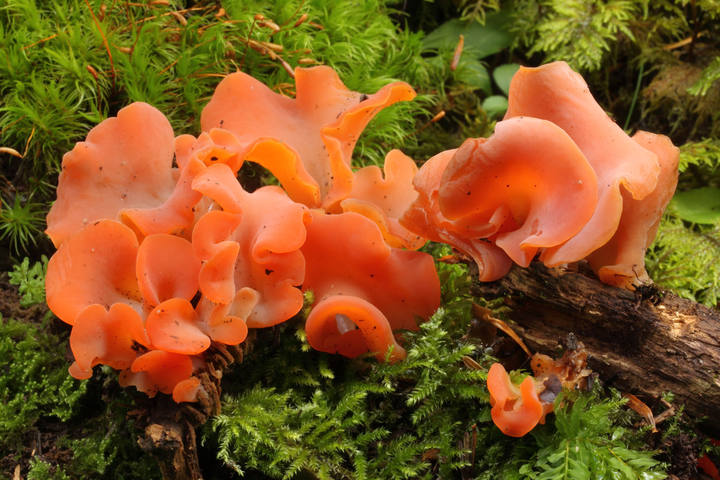

Autumn is mushroom season, and the woods are filled with fans or mycologists in its search. In order to help you know what type of fungus is found, whether it is edible or poisonous and where to find, the National Research Council (CSIC) has created a mobile application through the Royal Botanical Gardens.
The app is called FungiNote and November for downloading will be free only for devices with IOS operating system. The application initially has a database of 150 species of fungi, which will be extended with regular updates, as reported by the CSIC.
Each specie has a tab with a reference photo, name, conservation status, geographical distribution or whether it is edible or not. In some cases, illustrations have been introduced in the eighteenth, nineteenth and early twentieth centuries, as explained the researcher of the CSIC Royal Botanic Gardens, Maria Paz Martin.
Users can search the fungus found in the database with the help of search filters, introducing one or more characteristics that match the description of the species. These filters analyze the morphology, the season and the habitat where the fungus has been found and the information provided funds the Royal Botanic Gardens, the application selects species sheets with the most likely outcomes.
In addition to identifying the fungus sighted, FungiNote can know all the information on the issue: their different names, the etymology of the taxonomy, conservation status, geographical distribution, curiosities and whether it is edible or not, among other data.
"Mycology enthusiasts can have all this information quickly and easily, but remember that this is reference information for the identification of fungi is not intended to be a guide for human consumption. If in doubt about the toxicity of a copy is recommended not collect it or ingest it", adds Martin.
In addition to the query function, FungiNote allows you to create a custom field notebook to write down the findings, locations, dates and include photos of yourself.
"This custom file can be kept private or, if you want, shared online with other users of the application. This application seeks to strengthen the social aspect of this hobby, and invites mycologists to share and discuss their own findings and those of others with the whole community of fans", concludes the researcher.
"This initiative fulfills one of the goals that has raised the CSIC for next years: bring the company to the lab and back to promote products to be obtained that can reach society. This new technology also will continue to implement the result of ongoing work among the CSIC and the company ", says the researcher Alicia Castro.
The application has been developed by the Spanish company Wake App! In the development of content and reference images have helped members of the Catalan Society of Mycology and the Mycological Society of Madrid.
If you want to make Mycological Tourism, these are the places in Spain where you can find more and better quality mushrooms:
Barcelona: Escape to the region of Berguedá for a journey through the woods Puigventós Pla.
Zamora: One of the best places in Spain to look for mushrooms is Rabanales, where you can also find the most documented Mycological Museum of the country.
Lleida: Visit a Pyrenean region near the valley of Aran, The High Ribagorça, will not disappoint you.
Navarre: You will can do the Unzúe route of 11 kilometers, with a big variety of different mushroom species.
Huesca: Interestingly the Echo Valley. The best places to find specimens are Aragüés Valley Port, Gabardito area, the Valley of the Hospital and Selva de Oza.
La Rioja: There are two municipalities with mycological tradition: Ezcaray and Igea. We also recommend you, as places with mycological attraction: Torre en Cameros, Zarzosa, Munilla Villaroya and Aguilar del Río Alhama.
Madrid: The Sierra de Madrid has some forests full of mushrooms, such as Pinewoods Llanos, Fuenfría and Lozoya.
Malaga: Visit the Natural Park Sierra de las Nieves, one of the best places to look for mushrooms in Andalusia. You can find 400 species, although some of them are highly poisonous.Watch out!.
Soria: Approach Forests of San Leonardo and Navaleno. Moreover, the latter has a center from which are organized Mycological routes around all weekend.
Well, I hope that everything of this can help you and I also hope that you like to search mushrooms and you come to Spain, in orther to search in any good place.
Till soon, kind regards,
Luis.
Sponsored by Costaluz Lawyers.
Please click down here:

 0
Like
Published at 8:09 PM Comments (0)
0
Like
Published at 8:09 PM Comments (0)
Fulfill the wish of a child in Spain
Wednesday, November 13, 2013
The “Make a wish” Foundation, born in the United States -- and already in Spain --, is dedicated to bring happiness to those children who are sick and need to fulfill a desire to feel more strong themselves, tackling their hard treatments.
For example, in the U.S., they are now preparing a child's dream from San Francisco, called Miles. This child, five years old, has leukemia and his biggest dream is to help Batman to rescue a lady. Then, "Make a wish" has managed to organize everything so that next November 15, Miles meets Batman - with which eat at a Burger and then go to rescue a woman, chasing all over the town, to the bad guy (Ridler), who has kidnapped this lady -. Miles will be Batkid.Please click on this link:
http://abclocal.go.com/kgo/story?section=news/local/san_francisco&id=9315337
In Spain, “Make a wish” is directed by Carmela Fernandez Piera.
“Make a wish” was born in USA, in 1990.And they wanted to open a Foundation in Spain. So it was how they found to the Spanish Foundation “Illusions”, in 2009. Since that moment “Make a wish” was born in Spain, because “Illusions” had the same values than “Make a wish”.
“Make a wish Spain” has been in Barcelona, from 2009 till 2013. But last year, 2012, they opened the Foundation in Madrid too.

In Make a wish, they work the illusions, as treatments of life. Then, they work with children (among 3 and 18 years old) with serious illnesses. Who calls to Make a wish?; well, the child, the father, the mother or the doctor has to call. From here, Make a wish create a team of working, where are: the child (the Director, the Boss), his or her family and the Doctor –“Make a wish” does not meke anything without the doctor's permission, because the Doctor has a great responsibility (for example, a time, a boy, who could hardly breathe, he had the desire to swim with dolphins)--.
Carmela says that, with this work, they get that a child knows that if he or her is able to get the illusion of his or her life –and work for getting it, because “Make a wish” does not give awards, either surprises…., no, because is the child the protagonist and who has to get (to work) its wish--.Well…any surprise can be appear –for example, Miles knows he will be “Batkid”, but he does not know that he will meet the Council of San Francisco, who will give Miles the key of the city. Then, the child has a work for several months --depending of its illness--; for example, the child has to draw a picture. Another work for a child is for example to eat vegetables.
Carmela also says that Doctors are pleased.Carmela Spent a morning with the Doctor Mora. The Doctor Mora , one of the Trustees of the Foundation , believed in this from the beginning; Carmela told him : "Give me data " , and he said : " Look, scientifically I would like to have a studio , but I have none and I can not give you facts and scientific data , but at the doctor level ......it is amazing how changing a child ... : his attitude and especially his willingness - and their family - " . Carmela says , "I have seen parents who were sunk in misery , and make their illusion root , changed their attitude , but above all for the boy, his reaction to the treatment . Carmela also says that may be the doctor himself which they call , and in this sense , there is a beautiful story : a girl. Mirella , who was 16 and had a very serious disease , but the disease did not accept ... she was stuck in a depression ... she had not told their friends ... and it was her doctor who called " Make a wish " to ask help.They spoke with Mirella : they asked her what made illusion to her, but she was saying that anything not to illusion . but in the end , the team at Make a wish , got get her dream was to climb one of the tallest buildings in the world - was taken to the Empire State - to shout “I am going to heal” ." So that was how to tell the world : "I am sick " .
Well, I hope that you have liked this project. If you want to know more about it, please click on this link (in Spanish):
www.makeawishspain.org
and...in Englih:
http://www.make-a-wish.org.uk/
Till soon, kind regards,
Luis.
Sponsored by Costaluz Lawyers.
Please click down here:

 0
Like
Published at 12:53 AM Comments (0)
0
Like
Published at 12:53 AM Comments (0)
Prevent disease in Spain
Tuesday, November 12, 2013
A Spanish team, consists of 12 researchers, has discovered a way to detect disease earlier.
They have used Nanotechnology to differentiate cancer cells from healthy cells. With the Nanotechnology, they approach the physical properties of the cells.
This is a project of the CSIC (High Center of Scientific Researches), but with European funding.
Nanoforcells, which would be an abbreviation of the name 'Nanotechnology for cells', is a project of CSIC Biomechanics Laboratory whose main objective is to study the mechanical properties of the cells to differentiate cancer cells from healthy cells through their properties physical. It is one of the projects that have been released to mark the 2013 Science Week, which is celebrated throughout Spain.
Through a new avenue of research, a team of 12 people led by researcher Montserrat Calleja, uses micro and nanofabrication tools for basic cell information; so we can develop future forms of early diagnosis of diseases such as cancer , among others, as Calleja explained to RTVE.es.
Nanoforcells is a basic research project that began in 2011, funded with EUR 1.5 million European Research Council, which aims to provide tools for hospitals to diagnose disease in about ten years.
The Physics, Montserrat Calleja, explained so far and in general, research was focused on the chemical properties of the cells. This avenue of research "has given very good results", in her view, and it allowed inhibit malignant cells through a biochemical pathway.
The investigation of the physical properties of the cells, through Nanotechnology, is a relatively new scientific approach, that is developing around the world and in the laboratory at the Institute of Microelectronics (IMM), in the CSIC.
Nanotechnology is the science that studies how the properties of materials change when their dimensions are reduced to the size of a nanometer, I mean, one millionth of a millimeter. To get an idea of the tiny size, equivalent to a DNA molecule.
"We seek to determine the mechanical properties of many cells very quickly, reliably and consistently" stressed Calleja, who said "is a tool and can allow other treatments”. She also said that “The cancer cells are vibrating, as opposed to healthy, which are stiffer”.
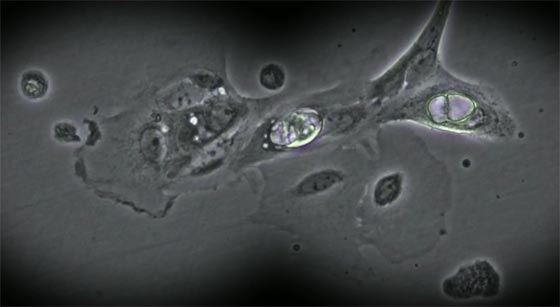
A cell view with instrumentation of the Biotechnology Laboratory of CSIC
The researcher (the Doctor Calleja) has indicated that the cells are living organisms that pass through different states that occur in different physical properties. A healthy cell and a cancer cell can be identified by properties such as elasticity, for example.
Thus the cancer cells are vibrating, as opposed to healthy , which are more rigid; but for detecting this movement, in an extremely small size, it is necessary to use nanotechnology.
Nanoforcells team, composed of scientists from different disciplines --Biology, Physics, Engineering or Math--, with biomechanical sensors studied three types of cells: healthy, non-malignant cells, which do not produce metastasize and malignant cells that do occur.
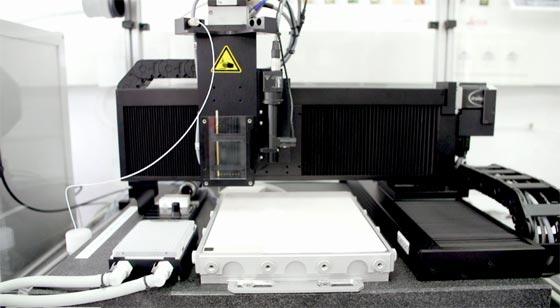
Instrument for biofunctionalization of the nanomechanical sensors
Sensors, which themselves are manufactured in the laboratory, are nanomanufactu silicon rods deform when biomolecules interact on its surface, since each protein has a different weight. The team measured their physical response, allowing them to detect whether a given protein is in a sample. The already have detected more than 50 different relevant analytes.
Also, as revealed Calleja, believe that the vibration could be related to the ability of cells of blood vessels or through narrow pores, reaching and metastasize to distant organs.
Calleja is working since 2005, in the IMM, in different lines of research. They started with a team of four people to reach the 12 scientists, some very young-2011. Have focused on developing instrumentation line "fundamental for understanding the mechanism of signal transduction via mechanical sensors”.
They also have a line of optomechanical, ie optical and mechanical sensors to miniaturize the size of a silicon nanowire, to weigh individual proteins. Finally, indulge in the mechanical characterization of cells.
In 2008, the team created the company Mecwins, in the technology park of Madrid, with the objective to develop and monetize molecular diagnostic tools that create in the IMMThey are some unique tools, that answer questions, related to biology and that they do not exist on the market.
Moreover they have patented various methods and mechanisms through CSIC, whose profits go into common stock of the institution, as pointed Montserrat Calleja, who has emphasized the jobs that have been creating these projects.
The researcher also noted that during his research have been taking risks since their work has "no guarantees" and has sentenced young researchers now "Hard times". "The competition is great and we are looking for established European projects. Youth represent the creative force of the research groups" said.
Regarding the reduction of funds for science in Spain since 2009, CSIC scientist commented that "no money to advance a competitor can make you overcome" and has warned that a project that does not get the funding may suffer delays of five to 10 years.
I hope that you do think that it is as interesting as I do.
Till soon, kind regards,
Luis.
Sponsored by Costaluz Lawyers
Please click down here:

 0
Like
Published at 1:36 AM Comments (0)
0
Like
Published at 1:36 AM Comments (0)
A folding helmet is invented in Spain
Saturday, November 9, 2013
Yes, in the Polytechnic University of Valencia, a group of Engineers has invented a folding bike helmet.
Here you can watch a video, which gives you the explanation:
http://www.rtve.es/alacarta/videos/telediario/grupo-ingenieros-universidad-politecnica-valencia-desarrolla-casco-plegable-para-bicicleta/2130407/
The speaker of this video says: “With this simple movement, the helmet is folded and placed in the bag, the action summarizes the work developed by a group of Engineers of the Polytechnic (University) of Valencia, next to the Institute of Biomechanics, which has employed unique technology in Spain, for the hull design………….The helmet set with three pieces, which move in a telescopic way; absorbs impact, leaning one piece on another”.
Carlos Ferrando (Helmets Closca Founding Partner): “It is a similar mechanism that can happen with cars, ranging collapsing parts, instead of being a rigid chassis, bouncing upon impact”.
The speaker: “The lack of funding in Spain, made them to search other routes;they found them on the Internet”.
Rafael Cerdá (Helmets Closca Founding Partner): “We present the project, people like .... brings money ..., what rafter of what? ..... Once fulfilled the necessary money, is given a gift, this gift what is it? ... a helmet”.
Paco Alonso (the speaker. Drawing Community of Valencia): “This is Crowd Funding (Micro Mecenazgo). With this system, they have managed the 45,000 dollars, they needed to start manufacturing in series”.
This is too interesting. Is not it?.
Till soon, kind regards,
Luis.
Sponsored by Costaluz Lawyers.
Please click down here:

 0
Like
Published at 9:41 PM Comments (0)
0
Like
Published at 9:41 PM Comments (0)
Tribute to a Classic Spanish guitarist
Friday, November 8, 2013
The last November-9, the guitarists Pedro Soler and Philippe Mouratoglou played their guitars, as a tribute to the magnificent Spanish Guitarist, Isaac Albeniz, in The Circle of Fine Arts of Madrid.
In 1887, Isaac Albeniz started a very important career, through the popular Spanish music, in order to discover the rich Folklore, which composes it.
Albeniz was a great pianist, but he also played other instruments.
Today there are many musicians who can interpret Albeniz pieces, but I want to talk about two of them: Pedro Soler and Philippe Mouratoglou. They play guitar and have offered a tribute concert, on November 9, as I said before. Between other pieces, they have interpreted: "Rumors of the creek" and "Malagueña". I have not found any video, about these two pieces, but I have been listening them on the radio, if you also want doing the same, you can listem them clicking on this link:
http://www.rtve.es/alacarta/audios/la-noche-en-vela/noche-vela-recuerdos-caleta-homenaje-isaac-albeniz-08-11-13/2128148/
Pedro is one of the deans of guitar teachers in Spain. Since he was a child, he has fed from Flamenco, thanks to exiled from Granada, as Jose Maria Rodriguez. How should be his art in handling the mast and ropes, that, being very young, the singer Jacinto Almaden hired him as their second guitarist. Since that time, Pedro began to turn the entire Postwar Spain, even got to play for several European countries. Pedro rubbed shoulders with the most select of the flamenco clubs, sharing the stage with legends such as Enrique Morente and Pepe of the Midwife, even flirted with the new Chilean song, recording with artists such as Atahualpa Yupanqui.
Now, you can watch a video of Pedro, playing guitar; I do not know the title of this piece:
By other side, Philippe Mouratoglou Is a guitarist covering a so broad range of styles. His complete musical training allows him to delve into creations, both contemporary and classic, which he operates safely.
Here you can watch a video of Philippe:
Now, you can watch a video of the piece "Rumors of the creek", by Jose Manuel Dapena, playing guitar:
http://www.youtube.com/watch?v=wkj7tJQ8dGs&list=PL8C3EEFDBA9A7EA1E&index=67
And, here, you can watch another video with the same piece, but playing piano, by a girl, but I do not know her name, I am sorry:
Well, I hope that you have enjoyed everything.
Till soon, kind regards,
Luis.
Sponsored by Costaluz Lawyers.
Please click down here:

 0
Like
Published at 8:30 PM Comments (0)
0
Like
Published at 8:30 PM Comments (0)
Spanish Educational support for children in their homes
Thursday, November 7, 2013
Today I want to talk you about a new project in Spain: El Servicio de Apoyo Educativo Domiciliario (SAED) = The Household Educational Support Service. This service is designed for children who are sick and can not go to school for over a month. This program is funded by various public entities.
Two teachers, specialized in scientific-technological sphere and in the linguistic sphere, go to the child´s home to tech him or her, who is ill.The teachers go 4 days in a week and around two hours and half each day.They try to teach the same or the similar things than in the Institute are taught.These two teachers organized often a meeting with the teachers of the Institute –where the child goes to study--, in order that the teachers of the Institute tell to the other ones which exercises and exams the child has to do.
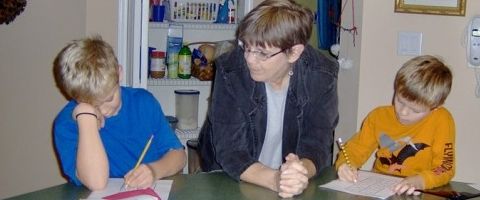
This project is very important, above all for children, because as they are ill –many times, their illnesses are serious, they do not want to laugh; but these teachers get a laugh out of them.This is what many childrens´parents tell to these teachers.
Any child of Elementary and Secondary is eligible for this program.
When these two teachers go to a home, any adult has to be there; those teachers never can be alone with the child, because as the child is ill, any adult, normally his or her father or his or her mother, as head of the child.
This Service works in all Spain.
Although this Service is thought to help children at home, really it is composed by 4 parts: The SAED for Elementary, the SAED for Secondary, the Hospital Classrooms and the Day Hospitals. The Hospital Classrooms are in public hospitals and they are for children who have to satay there for a short time –some hours or few days; but sometimes the time can be longer--. And the Therapeutic Education Centers are Centers for children with mental health problems to receive therapeutic treatment, by professionals, in addition to receiving teaching classes.
In this Service, each teacher has to work for one year and, after it, he has to say if he wants to follow with the program.
Also inside this Service there is a team of translators, for 20 languages.
I did not know this Service and I and happy knowing that it exists.
Till soon, kind regards,
Luis.
Sponsored by Costaluz Lawyers.
Please click down here:

 0
Like
Published at 11:53 PM Comments (0)
0
Like
Published at 11:53 PM Comments (0)
The largest pool of Spain
Wednesday, November 6, 2013
I did not know that in the Canary Islands is celebrate such a curious party in such a larg pool. The presenter (Francis Lorenzo) of the program “Spain flush with sky” tells us about that party.
Here you have the video of this festival:
http://www.rtve.es/alacarta/videos/espana-a-ras-de-cielo/espana-ras-cielo-francis-se-da-buen-chapuzon-fiesta-del-charco/2108702/
Francis Lorenzo: “There is little time for these 15,000 people from getting to fish by hand in the famous pool of the village, as did the aboriginals.
The size of this pool are similar to those of a football field”….
Now you can read on the image: Field measurements San Mames, Bilbao.
“It is attached to the sea and the water rises and falls with the tide. Inside, get caught hundreds of fish that are caught with hands. The people come gradually, this lagoon, with its wicker baskets, one lives a curious nervousness in the air, the minutes are eternal, we are all looking forward to start this traditional holiday".
Now you can read on the image: Since 1950, a rocket is used to start this ancient rite.
"No participant can cross the white line that surrounds this pool, until such time as the Mayor lights the rocket………… fun begins : 15,000 people go mad at once, the show is unusual, the pond looks like a pressure cooker ...... ".
Now you can read on the image: For centuries, fishing was banned for fear that the fish were contaminated.
Francis says: “¡Quieto, que hay uno!” (“Still, there is one!”), “¡Ya tenemos uno!” (“We have one!”, “¡Vamos a por otro! (Let the other!”).
Now you can read on the image: With the massification of the festival, the traditional costumes are mixed with the swimsuits.
“Leisure, which embodies the tradition, is more alive than ever, in the end, less is catch fish - although some are lucky and catch considerable copies –“.
Now you can read on the image: The lagoon is smooth fish, a species of temperate and tropical waters.
“Later, on the scale, you decide who are the winners; rewards the biggest fish and the most fish ...... In the village of San Nicolas Gran Canaria), we have seen how from a collective fishing tradition has emerged one of the strangest festivals of our country, which I had fun as ever".
I hope that you have enjoyed almost as Francis does.
Till soon, kind regards,
Luis.
Sponsored by Costaluz Lawyers.
Please click down here:

 0
Like
Published at 6:53 PM Comments (1)
0
Like
Published at 6:53 PM Comments (1)
Another Spanish sayings and proverbs, 52
Wednesday, November 6, 2013
Today, I want to show you another very popular Spanish saying:
A tiro hecho = To a shot made
This adverbial locution that, in theballistic order, designates mathematical certainty of the shot, in the colloquial level applies to those things which, by their nature, offer vehement likely met as more satisfying. It is often used, for example, when you want to go somewhere, to do something specific, and you do not need to take much time, because you will not do anything else than that, cause of that is said: "I am going to shot made". Another example: "I went very quiet at that auction, because he knew he was going to shot made".
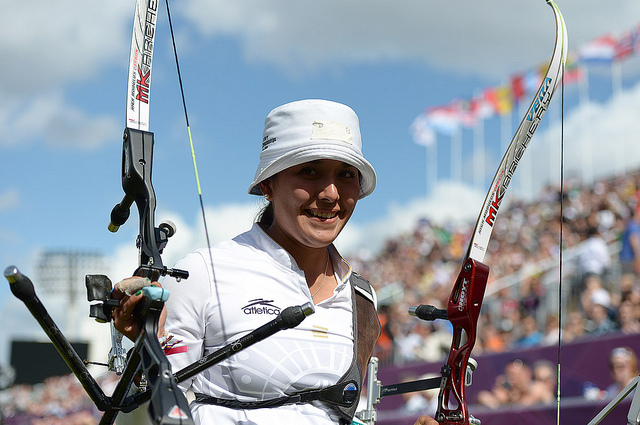
"Tiro con Arco/ Mariana Avitia", by Comision Nacional de Cultura Fisica y Deporte, at flickr.com
Tiro = shot also means “nail”, when you play football and you nail the ball.
I hope that you have liked this saying.
Till soon, kind regards,
Luis.
Sponsored by Costaluz Lawyers.
Please click down here:

 0
Like
Published at 12:04 AM Comments (0)
0
Like
Published at 12:04 AM Comments (0)
A work of Musical Comedy in Spain
Monday, November 4, 2013
Ángel Fernández Montesinos is one of the most prolific directors of Theatre in España.He has worked in several types of theatrical genres, but the Music is his favorite.
He was born in Murcia (East of Spain). He began his training at the University Theater in his city. He began his career with the premiere of "The Book of Good Love" by the Archpriest of Hita and "The Valencian Widow" by Lope de Vega, with Chamber Theatre "Dido", in the Theatre María Guerrero in Madrid.
In 1961 obtained the National Theatre Award. In 1962, the Gold Medal of Valladolid for Best Direction. During two seasons directed the Theatre Lara in Madrid, premiering "When you need me".
In 64, in Paris, at the Festival of Nations, he premieres the Musical "Fair eats and silent" by Alfredo Mañas, with music by Bernaola. This year he directs the lyric company of the Theatre of the Zarzuela in Madrid , getting a big hit with "La calesera". Later, he was appointed Principal Conductor of the Theatre, for three seasons. At this stage correspond titles like “Doña Francisquita”, “El Rey que rabió” (“The King who raged”) or “Tiovivo madrilène” (“Carousel of Madrid”).
For 15 years (from 62 to 77), head of the National Youth Theatre at the Theatre Maria Guerrero, directed and adapted works like "Dragon's Head", "Peter Pan", "The Blue Bird", "The Little Prince "," Platero and I "and" Don Quixote ".
In the year 72, again obtained, a second time, the National Theater Award. Throughout these years, has led to Actors and Actresses from the likes of Amparo Soler Leal, Irene Gutierrez Caba, Arturo Fernandez, Mari Carrillo, Sancho Gracia, Analia Gade, Conchita Montes, Aurora Redondo ....
He wrote and directed "On the street of Alcala" with Esperanza Roy and Paco Valladares. But he also wrote and directed "Mom, I want to be an artist", with Concha Velasco and Paco Valladares. Now I want to show you a video with some of this work and specifically with the piece "The Gateway", with Concha Velasco and Paco Valladares:
http://www.youtube.com/watch?v=_l_pHDPVfyQ
Angel has been awarded with the Medal of Fine Arts, the Award Sigismund of Stage Directors Association of Spain -- of which he is Founder and President of Honor --.
Overall, he has worked on 160 works.
The last survey was in the past Classical Theatre Festival in Almagro, where he received a fitting tribute.
He says he has a new project: a musical, titled "Saved by the Music", but still do not want to produce, up to lower VAT tax (Value Added Tax).
Well. I hope that you have liked and enjoyed.
Till soon, kind regards,
Luis.
Sponsored by Costaluz Lawyers.
Please click down here:

 0
Like
Published at 11:39 PM Comments (0)
0
Like
Published at 11:39 PM Comments (0)
Spam post or Abuse? Please let us know
|
|